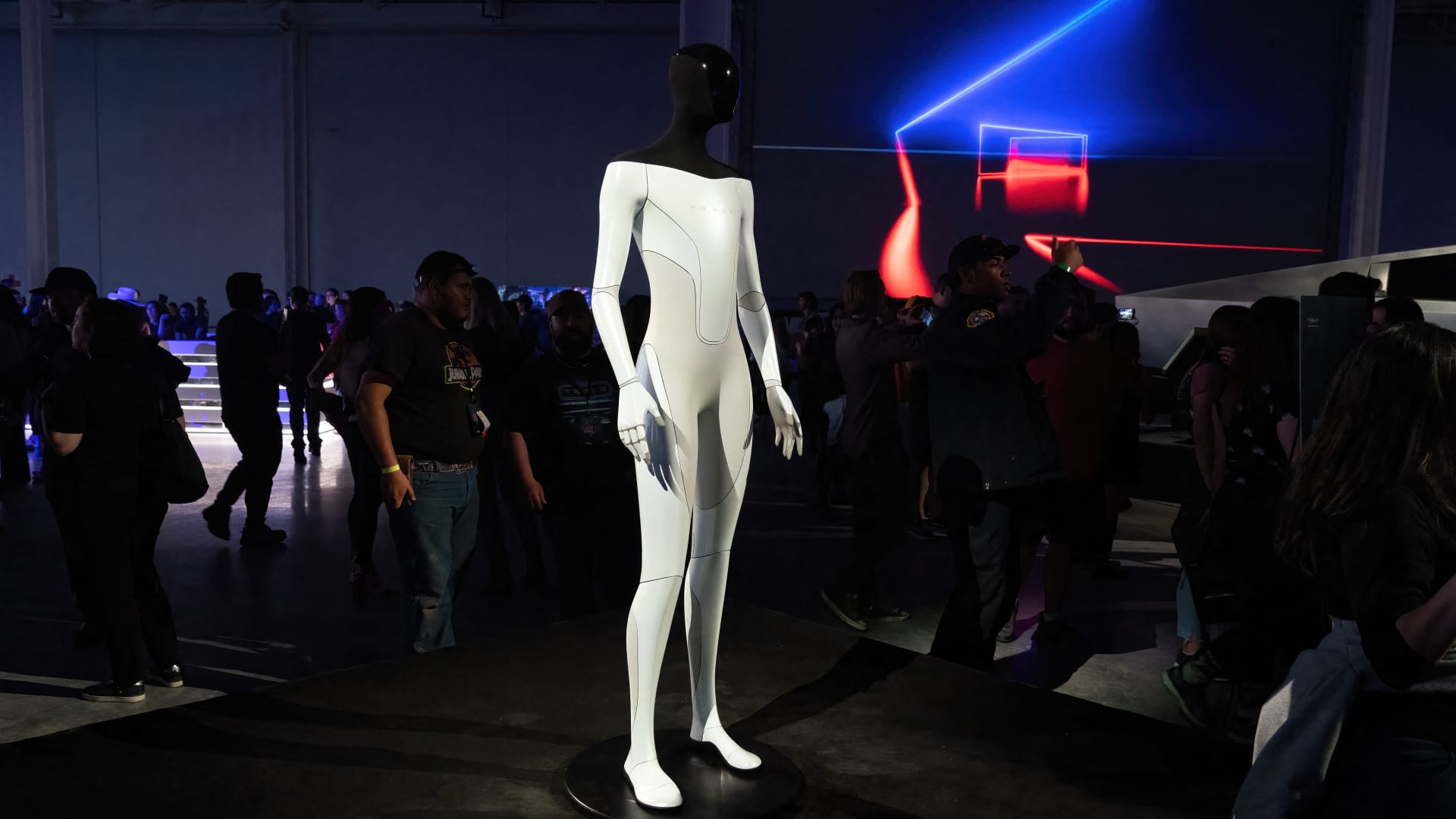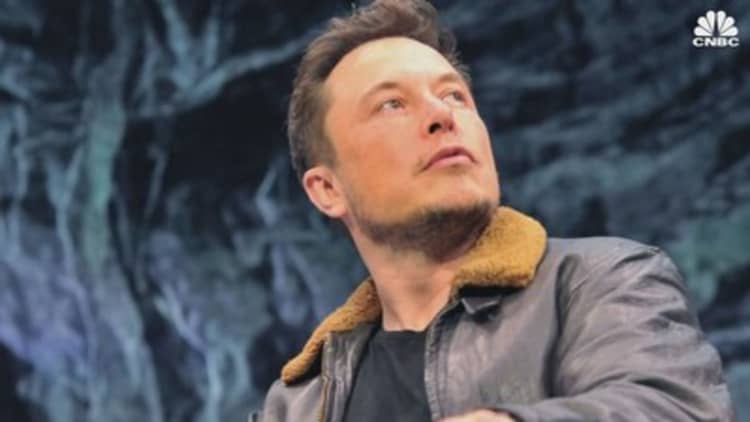
The Tesla Bot is on display at the Tesla Giga Texas manufacturing facility during the “Cyber Rodeo” grand opening party on April 7, 2022 in Austin, Texas.
Suzanne Cordeiro | AFP | Getty Images
Should robots look like people? Elon Musk, who is expected to reveal more about his humanoid robot at this year’s Tesla AI Day on Friday, seems to think so. In contrast to a robotic arm that performs a specific manufacturing task, the Tesla Bot, or Optimus – its name a nod to the “Transformers” franchise – is meant to perform more general purpose duties.
According to job postings by Tesla, the Optimus will first be rolled out in the thousands in its own factories, with an eye ultimately toward consumer applications in the home. Musk said in a Ted interview that touches on robots that these household applications could range from activities like mowing the lawn and picking up groceries and caring for the elderly, all the way up (or down) to being a “buddy” or more intimate “friend.”
Musk clearly has an eye for products that seize the imagination of the public: commercial space travel, fully self-driving cars and, now, humanoid robots. “Robots are a prevailing object used to evoke our technological future,” said Anne-Laure Fayard, a professor at Nova School of Business and Economics (SBE) in Lisbon, Portugal and visiting research professor at the New York University Tandon School of Engineering. “They reflect our hopes and fears about technology.”
It’s clearly on brand for Tesla, and within its growing computing wheelhouse. As Musk stated at the Tesla AI Day last year: “If you think about what we are doing with cars, Tesla is arguably the largest robotics company in the world, because our cars are semi-sentient robots on wheels.”
But Fayard, and other robotics experts, say a basic question still needs to be answered: “What these robots can really do.”
Last year’s Tesla AI Day included a human dancing around in an Optimus suit, something that has left some experts skeptical about the humanoid robot’s ultimate potential. Nancy Cooke, a professor in human systems engineering at Arizona State University, said the real key is that it be able to do unscripted actions. “If he just gets the robot to walk around, or he gets the robots to dance, that’s already been done. That’s not that impressive,” Cooke said.
Others have pointed out that truly self-driving cars and robotaxis – the proof for Musk’s claims that Teslas are semi-sentient robots on wheels – remain unfulfilled promises, with targets and deadlines pushed out several times. In 2019, Musk promised one million robotaxis by 2020 and there are currently none on the road.
But Tesla isn’t the only company behind on self-driving goals or pushing the boundaries of robot design. Honda, Boston Dynamics, and Hyundai have been working on humanoid robots for decades.

One big stumbling block – shared with self-driving vehicles – is what happens when robots encounter unpredictable scenarios.
Musk, who has proved critics wrong in the past, is aware that the success of the Optimus project will rest on the robot’s ability to think and perform “unscripted actions.”
The real key will be whether it can “navigate through the world without specific line-by-line instructions,” he said at the AI Day last year, adding that ultimately “it should be able to do that.”
This year’s AI Day featured the humanoid robot prominently, if playfully: the invitation includes robotic hands making a heart symbol.
Part of the reason for building a robot that is human in form is that, if it is going to be performing multiple unscripted tasks — pick up that box over there, go to the store and get eggs — it will have to be able to move through a world built for humans: presumably, having a human form is the best promise of being able to do so.
The incident of the so-called “fluff bot,” a robotic piece of equipment that caused production problems due to its inability to perform a relatively simple task, which Musk later said was more readily performed by “human hands,” is sometimes marked as a key moment for the humanoid Tesla bot. But one limitation on this line of thinking, according to robotics engineers, is that we still don’t really understand very well how human bodies are able to do what they do. It’s not a simple process to reverse engineer their movement capabilities.
Elon Musk looks at a robot display during a tour of the new Tesla Motors auto plant, formerly operated New United Motor Manufacturing Inc. (NUMMI), in Fremont, California, U.S., on Wednesday, Oct. 27, 2010.
Bloomberg | Bloomberg | Getty Images
How much the humanoid robot will actually be able to do is a compound problem of mobility and AI capabilities, according to Eni Halilaj, assistant professor in mechanical engineering at Carnegie Mellon and a researcher who studies human movement. Mimicking human mobility is going to be limited, in part, by limitations already in place about current knowledge of how human mobility works in humans.
“Our body is a complex engineering system that we still do not fully understand,” Halilaj said. “We have a long way to go to reverse engineer it, making motion planning and control challenging for humanoid robotics. For example, we still do not understand how our central nervous system selects specific muscle coordination patterns to carry out daily tasks — this is one of the grand challenges in biomechanics and neural control.”
“Biomimicry can be only as successful as our understanding of the biological system,” she said. Mimicking a biological system is a task self-driving cars don’t face. “It is true that cars are robots on wheels, but cars are human-made inventions,” she added.
More collaboration between the robotics community and biomechanists, neuroscientists, and behavioral scientists to build plausible human digital twins — computational models that can accurately capture the complexity of the neuromusculoskeletal system and navigate virtual environments with the fluidity and elegance of our biological systems — should be a broader goal in this area of robotics.
And until such knowledge is in place, “We’ll see progress, but not at the transformative level we could if we bolstered fundamental research in human intelligence,” Halilaj said.
